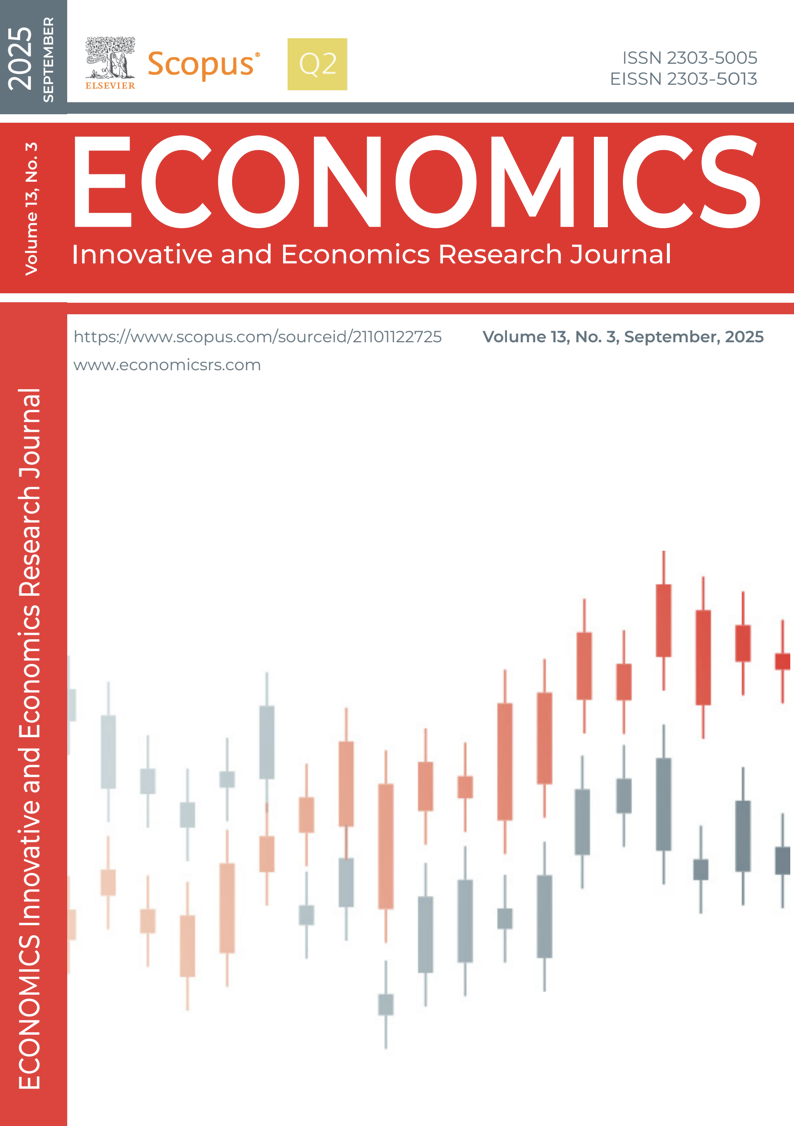UNRAVELING THE ASYMMETRIC DYNAMICS OF OIL PRICE SHOCKS AND MARKET VOLATILITY ON STOCK RETURNS: EVIDENCE FROM NARDL PANEL APPROACH
DOI:
https://doi.org/10.2478/eoik-2025-0059Keywords:
Oil Price Shocks, Market Volatility, Liquidity Shocks, Stock Returns, NARDL, Risk Premiums, Global FinancialAbstract
This study explores the asymmetric oil price shock dynamics, market volatility, liquidity shock, and stock returns in a panel of nations during the period 2000-2024. Using the Nonlinear Autoregressive Distributed Lag (NARDL) panel method and application of robust econometric techniques, we explore the impact of changes in oil prices on market volatility, erode liquidity levels, and subsequently influence stock returns. We show that our findings are associated with large asymmetries, whereby stock returns respond more to the rise than fall in oil prices, and that market volatility increases during periods of negative shock. We find that increased volatility also amplifies liquidity shocks so that risk premiums rise and stocks return less. We also discuss regional differences as well as how macroeconomic conditions moderate these channels. The evidence highlights liquidity as a principal mechanism of transmission from volatility to the performance of the stock market and indicates its role in determining global equity returns. The study contributes to financial market behavior knowledge and provides valuable implications for policymakers and investors with a requirement to work through periods of economic uncertainty.
References
Amihud, Y. (2002). Illiquidity and stock returns: cross-section and time-series effects. Journal of finan-
cial markets, 5(1), 31-56. https://doi.org/10.1016/S1386-4181(01)00024-6
Amihud, Yakov, et Haim Mendelson. (1986). « Asset pricing and the bid-ask spread ». Journal of Finan-
cial Economics 17(2), 223‑49. https://doi.org/10.1016/0304-405X(86)90065-6
Ang, A., Hodrick, R. J., Xing, Y., & Zhang, X. (2006). The cross‐section of volatility and expected re-
turns. The journal of finance, 61(1), 259-299. https://www.jstor.org/stable/i370858
Aworunse, O. S., Olorunsola, H. A., Ahuekwe, E. F., & Obembe, O. O. (2023). Towards a sustainable
bioeconomy in a post-oil era Nigeria. Resources, environment and sustainability, 11, 100094.
https://doi.org/10.1016/j.resenv.2022.100094
Bani-Khalaf, O., & Taspinar, N. (2022). Oil and gold return spillover and stock market elasticity during
COVID-19 pandemic: A comparative study between the stock markets of oil-exporting coun-
tries and oil-importing countries in the Middle East. Resources Policy, 79, 102935. https://doi.
org/10.1016/j.resourpol.2022.102935
Będowska-Sójka, Barbara, et Agata Kliber. 2019. « The causality between liquidity and volatility in
the Polish stock market ». Finance Research Letters 30 (October 2018), 110‑15. https://doi.
org/10.1016/j.frl.2019.04.008
Bouri, E., Demirer, R., Gupta, R., & Pierdzioch, C. (2020). Infectious diseases, market uncertainty and
oil market volatility. Energies, 13(16), 4090. https://www.mdpi.com/1996-1073/13/16/4090
Brunnermeier, Markus K., et Lasse Heje Pedersen. 2009. « Market liquidity and funding liquidity ».
Review of Financial Studies 22(6), 2201‑38. http://dx.doi.org/10.2139/ssrn.688065
Ceyhun, G. Ç. 2023. Navigating the Dichotomy: Maximizing Maritime Trade Profits and Mitigating
Black Carbon Impact in the Arctic. Journal of Green Economy and Low-Carbon Development,
(4), 202-212. https://doi.org/10.56578/jgelcd020403
Chordia, Tarun, Richard Roll, et Avanidhar Subrahmanyam. 2001. Market liquidity and trading activity .
Journal of Finance 56(2), 501‑30. https://www.jstor.org/stable/222572
Chung, K. H., & Chuwonganant, C. (2018). Market volatility and stock returns: The role of liquidity
providers. Journal of Financial Markets, 37, 17-34. https://doi.org/10.1016/j.finmar.2017.07.002
Chung, Kee H., et Hao Zhang. 2014. A simple approximation of intraday spreads using daily data. Jour-
nal of Financial Markets 17(1), 94‑120. https://doi.org/10.1016/j.finmar.2013.02.004
Claessens, S. 2006. « Access to Financial Services: A Review of the Issues and Public Policy Objec-
tives ». The World Bank Research Observer 21(2), 207‑40. https://doi.org/10.1093/wbro/lkl004
Derouez, F., Alharbi, F., Mathlouthi, N., Ifa, A., Alrawad, M., & Ahmed, N. (2025). How Does The
Stock Market Development React To Energy Consumption? Evidence From The ARDL Panel
Approach. Economics - innovative and economics research journal, 13(1), 247–265. https://doi.
org/10.2478/eoik-2025-0006
Dumitrescu, E. I., & Hurlin, C. (2012). Testing for Granger non-causality in heterogeneous panels. Eco-
nomic modelling, 29(4), 1450-1460. https://doi.org/10.1016/j.econmod.2012.02.014
Fama, E. F., & French, K. R. (1993). Common risk factors in the returns on stocks and bonds. Journal of
financial economics, 33(1), 3-56. https://doi.org/10.1016/0304-405X(93)90023-5
Fama, Eugene. 1970. « Efficient Capital Markets: A Review of the Theory ». The Journal of Finance
(2), 383‑417. https://doi.org/10.2307/2325486
Granger, C. W. (1969). Investigating causal relations by econometric models and cross-spectral meth-
ods. Econometrica: journal of the Econometric Society, 424-438. https://doi.org/10.2307/1912791
Haroon, M. (2024). Energy poverty in the face of stringent environmental policies: an analysis of
mitigating role of energy storage in China, J. Energy Storage 81 (2024) 110396, https://doi.
org/10.1016/j.est.2023.110396
Unraveling the Asymmetric Dynamics of Oil Price Shocks and Market Volatility on Stock Returns: Evidence from
NARDL Panel Approach
Haroon, O., Rizvi, S.A.R., (2020), Flatten the curve and stock market liquidity–an inquiry into emerging
economies. Emerg. Mark. Finance Trade 56 (10), 2151–2161. https://www.taylorfrancis.com/
chapters/edit/10.4324/9781003214687-3/flatten-curve-stock-market-liquidity-inquiry-emerg-
ing-economies-omair-haroon-syed-aun-rizvi
Jarque, C. M., & Bera, A. K. (1987). A test for normality of observations and regression residuals.
International Statistical Review / Revue Internationale de Statistique, 163-172. https://doi.
org/10.2307/1403192
Levin, Andrew, Chien Fu Lin, et Chia Shang James Chu. 2002. « Unit root tests in panel data: Asymptot-
ic and finite-sample properties ». Journal of Econometrics 108(1), 1‑24. https://doi.org/10.1016/
S0304-4076(01)00098-7
Lin, J., Zhang, L., & Dong, Z. (2024). Exploring the effect of green finance on green development
of China’s energy-intensive industry—A spatial econometric analysis. Resources, Environment
and Sustainability, 16, 100159. https://doi.org/10.1016/j.resenv.2024.100159
Ma, R., Yang, T., Breaz, E., Li, Z., Briois, P., & Gao, F. (2018). Data-driven proton exchange membrane
fuel cell degradation predication through deep learning method. Applied energy, 231, 102-115.
https://doi.org/10.1016/j.apenergy.2018.09.111
Mpofu, Q. 2024. Determinants of Human Capital Disclosure in the Mining Industry: Comparative Anal-
ysis of South African and Zimbabwean Companies . Journal of Accounting, Finance and Audit-
ing Studies, 10(3), 168-178. https://doi.org/10.56578/jafas100305
Nagel, Stefan. 2012. « Evaporating Liquidity ». Review of Financial Studies 25(7), 2005‑39. https://doi.
org/10.1093/rfs/hhs066
Pástor, Ľ., & Stambaugh, R. F. (2003). Liquidity risk and expected stock returns. Journal of Political
economy, 111(3), 642-685. https://doi.org/10.1086/374184.
Protsenko, I. (2023). Legal Status and Peculiarities of Taxation of E-Residents in Ukraine. Collection of
papers new economy, 1, 244-255. https://doi.org/10.61432/CPNE0101244p
Tinic, Seha M., et Richard R. West. 1986. « Risk, Return, and Equilibrium: A Revisit ». Journal of Po-
litical Economy 94(1), 126‑47. http://dx.doi.org/10.1086/261365
Tissaoui, K., Hkiri, B., Talbi, M., Alghassab, W., Alfreahat, K.I., (2021). “Market volatility and illi-
quidity during the COVID-19 outbreak: evidence from the Saudi stock exchange through the
wavelet coherence approaches. N. Am. J. Econ. Finance 58, 101521. https://doi.org/10.1016/j.
najef.2021.101521
Toni, N. (2025). Supply Chain Sustainability And Financial Performance: The Role Of E-Commerce,
Digital Banking And Digital Marketing of SMEs. Economics - innovative and economics re-
search journal, 13(1), 487–507. https://doi.org/10.2478/eoik-2025-0027
Topić - Pavković, B. (2024). Challenges To Global Monetary And Financial Stability. Collection of pa-
pers new economy, 2, 31-45. https://doi.org/10.61432/CPNE0201031t
Treynor, J. L. (1961). Market value, time, and risk. Time, and Risk (August 8, 1961). https://ssrn.com/
abstract=2600356 or http://dx.doi.org/10.2139/ssrn.2600356
Wang, W. S., Ding, J. Z., & Zhou, Y. C. 2024. « Transmission Risk of Stock Price Fluctuations Among
Industries in Complex Financial Networks. Journal of Accounting », Finance and Auditing
Studies, 10(1), 37-50. https://doi.org/10.56578/jafas100105
Zaidi, S. A. H., Hussain, M., & Zaman, Q. U. (2021). Dynamic linkages between financial inclusion
and carbon emissions: evidence from selected OECD countries. Resources, Environment and
Sustainability, 4, 100022. https://doi.org/10.1016/j.resenv.2021.100022
Zhang, D., Hu, M., Ji, Q., (2020). Financial markets under the global pandemic of COVID19. Finance
Res. Lett. https://doi.org/10.1016/j.frl.2020.101528
Zhou, L., Gong, Z., Tian, L., & Chen, Z. (2024). Exploring the interconnection between international
crude oil and silver rates volatilities: Novel evidence from the COVID-19 pandemic. Heliyon,
Downloads
Published
How to Cite
Issue
Section
License
Copyright (c) 2025 ECONOMICS - INNOVATIVE AND ECONOMICS RESEARCH JOURNAL

This work is licensed under a Creative Commons Attribution-NonCommercial-NoDerivatives 4.0 International License.























